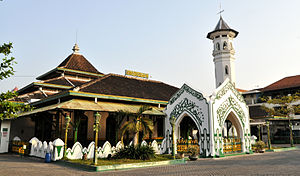Tajug
Tools
Actions
General
Print/export
In other projects
Appearance
Source: Wikipedia, the free encyclopedia.
Islamic architecture elements

Tajug is a pyramidal or pyramid square (i.e. an equilateral square base with a peak) ornament which is usually used for sacred buildings in Southeast Asia including Indonesia, such as mosque or cupola graveyard. It is considered derived from Indian and Chinese architecture, which has history since pre-Islamic era, although there's also an element of an influence from Indian mosques.[1] The term tajug is also used to refer to mosques or surau (Islamic assembly building) in some regions of Indonesia.
See also
References
- ^ Architecturalized Asia: Mapping a Continent through History
| Vernacular architecture |
| ||||||||||||||||
|---|---|---|---|---|---|---|---|---|---|---|---|---|---|---|---|---|---|
| Hindu-Buddhism in Indonesia | |||||||||||||||||
| Islam in Indonesia | |||||||||||||||||
| Dutch colonial | |||||||||||||||||
| Post-colonial & contemporary | |||||||||||||||||
| Styles | ||||||||||||||||||||
|---|---|---|---|---|---|---|---|---|---|---|---|---|---|---|---|---|---|---|---|---|
| Elements |
| |||||||||||||||||||
| Types |
| |||||||||||||||||||
| Resources | ||||||||||||||||||||
| Influences | ||||||||||||||||||||
| Category pages | ||||||||||||||||||||
This architectural element–related article is a stub. You can help Wikipedia by expanding it. |
Retrieved from "https://en.wikipedia.org/w/index.php?title=Tajug&oldid=1266138113"

